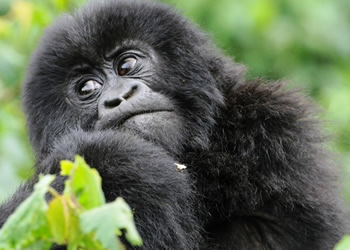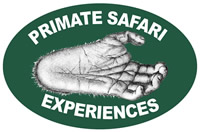
An Africa Safari tour to Encounter the Rare Mountain Gorillas in the Wild
PLaning a Gorilla Trekking tour in africa will encompass gorilla visit either to Bwindi or Mgahinga , Virunga national Park, Volcanoes national park in Rwanda. Africa Safari tours designed by Congo Gorilla Safaris will include gorilla trekking & Karisimbi Hike in Rwanda’s Volcanoes national park.
As mentioned by clients that select to visit Africa mainly come for two purposes either mountain gorillas or Wildlife viewing in uganda, Rwanda , Dr congo, Kenya and Tanzania.Although when its gorilla trekking trip, the best destination is to go gorilla trekking in Uganda , Rwanda or Democratic republic of Congo.
I waited enthusiastically for an opportune moment to go gorilla trekking so as to view for myself all about these highly hyped relatives of human being. When this D-day came, I grasped it with my widely open arms. We did set off for this expedition very early in the morning and within a brink of an eye we were at the park headquarters in Buhoma as we had not spent the previous night very far from it.We were welcomed by tea dispensers scattered all over the tables and we were asked to enjoy it free of charge. Then we were allocated gorilla families plus relevant tour guides and off we went to the starting point of this great expedition.
A snarl emanates from the dense jungle which seems to close in around us. “Don’t worry, it’s a friendly noise,” says our guide Benson who was very interactive and knowledgeable about this whole exercise. Another deep rumble. Swinging his rusty machete in wide swoops, Benson hacks at the tangle of vines branches and bushes until the source of the sinister grumbles comes into view.
Only a few meters away is Makara, the fearsome silverback and leader of the Habinyanja family of mountain gorillas that reside deep within Uganda’s Bwindi Impenetrable National Park. Climbing across his grey-speckled back are two playful juveniles. Spotting us, they venture close, peering through the thick undergrowth with big brown inquisitive eyes.
There’s a loud huff as Makara stirs, stands tall, glares at us. Nostrils flaring, he rushes forward without warning. Faced with 190kg of charging silverback, my knees buckle. I forget our earlier safety briefing immediately (the number one rule is ‘never run’) and scramble backwards.
“Nobody move,” warns Benson. “It’s a bluff. Nobody moves,” he repeats. Sure enough, Makara comes to an abrupt stop barely three meters away. Stalemate. Then he retreats. Gorillas sometimes charge but they have never attacked a tourist,” says Benson, who has been tracking these magnificent creatures for 16 years.
That’s a relief, because gorilla tourism is big business. Gorilla Permits cost $600 per permit and demand far outweighs supply. A maximum of 80 are issued daily and trekkers are evenly split between the eight families of gorillas that have been introduced to humans over a two-year period. Time with these jungle VIPs is strictly limited to one hour.
Bwindi Impenetrable National Park is truly remote and can make for a tough trek to find the primates. Of the 880 critically endangered mountain gorillas that remain in the wild, more than half are found in Bwindi Impenetrable National Park tucked away in a lush corner of south-west Uganda. The others are split between neighboring Rwanda and the Democratic Republic of Congo.
As the name suggests, Bwindi is an untamed wilderness; misty mountains cloaked with thick and almost impassable jungle that rise to heights of more than 2,000m.Visitors are given one hour to watch the gorillas in their natural habitat.
Reaching the gorillas takes considerable effort. Rangers tasked with locating them leave as the dawn dew settles over the silent peaks – hours ahead of the tourists, who set off at 8am. The trekking is tough – muddy, steep and challenging and can last from 30 minutes to eight hours, depending on where the gorillas have travelled overnight. The good news is sightings are practically guaranteed.
The gorillas may be the star attraction but there’s more to Bwindi than its furry primates. I spend a day meeting the many colorful local characters: the traditional medicine man who’s paid in fresh fruit, the banana beer brewers and the nomadic pygmy tribe who once lived in the forest. Their lives changed forever in 1991 with the formation of the national park. They were forced out, losing their homes. Many dream of returning to the forest but the younger generation appreciates the perks that come with their new lifestyle: healthcare, education, permanent housing.
There are few tourist lodges in the forest – but we are lucky enough to be staying in one of the most luxurious. The Sanctuary Gorilla Forest Camp, a collection of eight secluded timber tents offers plush living and oversized bathtubs overlooking the jungle. Best of all, gorillas often pass through the camp, pausing for a leafy snack outside the open-sided lounge.
My gorilla experience is pure Fossey. Makara’s charge came at the very beginning of our hour in his company. Afterwards, I glance nervously at my fellow hikers, wondering whether we should expect a repeat performance but Benson is quick to reassure us. “He’s a gentle giant”.
The rest of our time with Makara the silverback and his dozen-strong brood passes peacefully. Now unfazed by our presence, he sits twiddling a piece of thick bamboo in his massive fingers as though it were a cigar. In one swift movement he cracks it in half like a toothpick.
He barely gives a second look when one of the youngest gorillas comes bounding over to us, beating its chest wildly with both hands. Another adolescent male carefully climbs to the top of a small tree and perches perilously before the tree splinters and he falls down the trunk, hitting the ground and rolling backwards down the embankment.
“Two minutes left”, says Benson. And with that, the gorillas vanish into their emerald cosmos marking the end of our magical – if hair-raising – encounter.


Leave a comment: